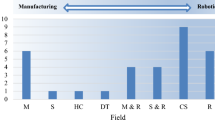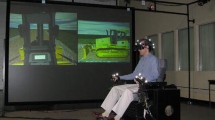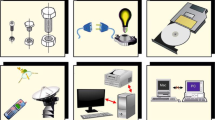Abstract
The development of a realistic virtual assembly environment is challenging because of the complexity of the physical processes and the limitation of available VR technology. Many research activities in this domain primarily focused on particular aspects of the assembly task such as the feasibility of assembly operations in terms of interference between the manipulated parts. The virtual assembly environment reported in this research is focused on mechanical part assembly. The approach presented addresses the problem of part-to-part contacts during the mating phase of assembly tasks. The system described calculates contact force sensations by making their intensity dependent on the depth of penetration. However the penetration is not visible to the user who sees a separate model, which does not intersect the mating part model. The two 3D models of the part, the off-screen rendered model and the on-screen rendered model are connected by a spring-dumper arrangement. The force calculated is felt by the operator through the haptic interface when parts come in contact during the mating phase of the assembly task. An evaluation study investigating the effect of contact force sensation on user performance during part-to-part interface was conducted. The results showed statistically significant effect of contact force sensation on user performance in terms of task completion time. The subjective evaluation based on feedback from users confirmed that contact force sensation is a useful cue for the operator to find the relative positions of components in the final assembly state.












Similar content being viewed by others
References
Abe N, Zhang JY, Tanaka K, Taki H (1996) A training system using virtual machines for teaching assembling/disassembling operations to novices. Proc IEEE Int Conf Syst Man Cybern 3:2096–2101
Adams RJ, Hannaford B (1998) A two-port framework for the design of unconditionally stable haptic interfaces. In: Proceedings IROS, Anaheim, CA
Baggett P, Ehrenfeucht A (1988) Conceptualising in assembly tasks. Human Factor 30(3):269–284
Baggett P, Ehrenfeucht A (1991) Building physical and mental models in assembly tasks. Int J Industr Ergon 7(3):217–227
Borst CW, Indugula P (2005) Realistic virtual grasping. In: Proceedings IEEE virtual reality conference (VR’05). Bonn, Germany, pp 91–98, 320
Borst CW, Indugula AP (2006) A spring model for whole-hand virtual grasping. Presence Teleoperators Virtual Environ 15(1):47–61
Carmel R, Ullrich C, Silver J (2001) VirtualHand v2.5 programmer’s guide. Technical Report, Virtual Technologies
Carpenter ID, Dewar RG, Ritchie JM, Simmons JEL (1996) Enhancing a virtual environment for manual assembly. In: Proceedings 12th international conference on CAD/CAM robotics and factories of the future, Middlesex University, UK, pp 1067–1072
Chryssolouris G, Mavrikios D, Fragos D, Karabatsou V (2000) A virtual reality-based experimentation environment for the verification of human-related factors in assembly processes. Robot Comput Integr Manuf 16(4):267–276
Colgate JE, Grafing PE, Stanley MC, Schenkel G (1993) Implementation of stiff virtual walls in force-reflecting interfaces. In: Proceedings IEEE virtual reality annual international symposium (VRAIS), Seattle, WA, pp 202–208
Homen De Mello LS, Lee S (1991) Computer-aided mechanical assembly planning. Kluwer, Dordrecht, pp 217–242
Delchambre A (1992) Computer aided assembly planning. Chapman and Hall, London
Dewar RG, Carpenter ID, Ritchie JM, Simmons JEL (1997) Assembly planning in a virtual environment. In: Proceedings PICMET’97, Portland, USA, pp 664–667
Dewar RG (1998) Assembly plans from virtual environments. PhD Thesis, Heriot-Watt University, UK
Fitts PM (1954) The information capacity of the human motor system in controlling the amplitude of movement. Exp Psychol 47:381–391
Garbaya S, Coiffet Ph, Blazevic P (2003) Experiments of assembly planning in virtual environment. In: Proceedings 5th IEEE international symposium on assembly and task planning (ISATP ‘03), France
Garbaya S, Coiffet Ph, Blazevic P (2001) Integrating computerised assembly planning with virtual assembly environment. In: Proceedings virtual reality in mechanical and production engineering (VR-Mech’01). Brussels, Belgium
Hu HH, Gooch AA, Creem-regehr SH, Tompson WB (2002) Visual cues for perceiving distances from objects to surfaces. Presence Teleoperators Virtual Environ 11:652–664
Gupta R, Sheridan T, Whitney D (1997a) Experiments using multimodal virtual environments in design for assembly analysis. Presence 6(3):318–338
Gupta R, Whitney D, Zeltzer D (1997b) Prototyping and design for assembly analysis using multimodal virtual environments. Comput-Aid Des 29(8):585–597
Jarayam S, Connacher H, Lyons K (1997) Virtual assembly using virtual reality techniques. Comput-Aid Des 29(8):575–584
Kokkevis E, Metaxas D, Badler NI (1996) User-controlled physics-based animation for articulated figures. In: Proceedings Computer Animation, Geneva, Switzerland, pp 16–26
Koutek M, Post FH (2001) Spring-based manipulation tools for virtual environments. In: Proceedings immersive projection technology and virtual environments. Springer, Stuttgart, pp 61–70
McNeely W, Puterbaugh D, James J (1999) Six degrees-of-freedom haptic rendering using Voxel sampling. In: Proceedings SIGGRAPH 99, ISBN 020148-560-5, LA, CA, USA, pp 401–408
Nevins JL, Whitney DE (1980) Assembly research. Automatic 16:595–613
Westenhofer W, Hahn J (1996) Using kinematic clones to control the dynamic simulation of articulated figures. In: Proceedings Computer Graphics International, Pohang, Korea, pp 26–37
Wilson J R (1998) Virtual environments and ergonomics: needs and opportunities. Ergonomics 40(10):1057–1077
Zachmann G, Rettig A (2001) Natural and robust interaction in virtual assembly simulation. In: Proceedings 8th ISPE international conference on concurrent engineering: research and applications. Anaheim, CA
Zorriassatine F, Wykes R, Parkin R, Gindy N (2003) A survey of virtual prototyping techniques for mechanical product development. In: Proceedings Inst. Mech. Engineers. Part B: J Eng Manuf 217(4):513–530
Author information
Authors and Affiliations
Corresponding author
Rights and permissions
About this article
Cite this article
Garbaya, S., Zaldivar-Colado, U. The affect of contact force sensations on user performance in virtual assembly tasks. Virtual Reality 11, 287–299 (2007). https://doi.org/10.1007/s10055-007-0075-5
Received:
Accepted:
Published:
Issue Date:
DOI: https://doi.org/10.1007/s10055-007-0075-5




